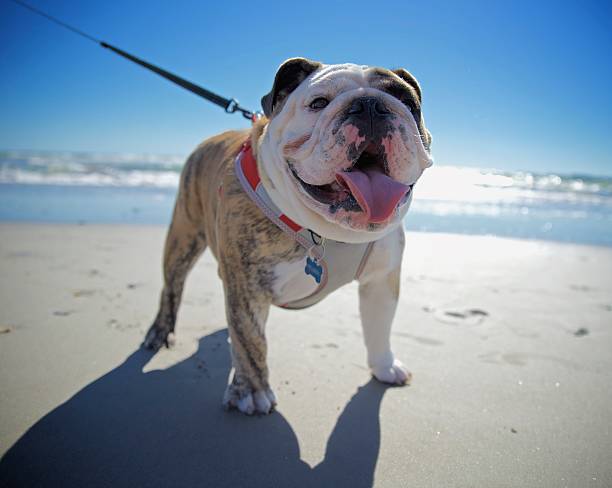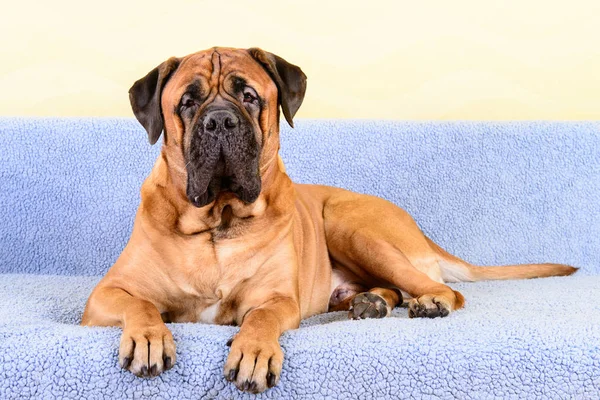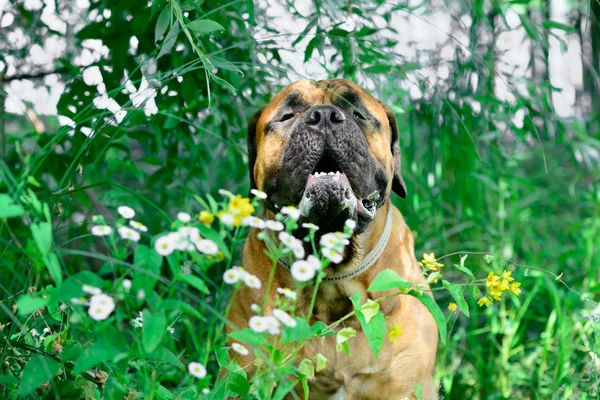The Bullmastiff, a majestic symbol of strength and protection, resonates deeply with those who seek a loyal and formidable companion. With its powerful build, gentle temperament, and unwavering devotion, this breed has earned its place as a cherished guardian and a symbol of canine nobility.

| Category (Explanation) | Breed Information |
|---|---|
| Year of Breed Conception | 19th century |
| Country of Origin | United Kingdom |
| Weight (Male) | 110-130 lbs (50-59 kg) |
| Weight (Female) | 100-120 lbs (45-54 kg) |
| Coat Type | Short, dense |
| Color Variations | Brindle, fawn, or red |
| Shedding Level | Low |
| Height (cm & in) | 25-27 inches (64-69 cm) |
| Breed Size | Large |
| Trainability | Moderate |
| Mental Needs | Moderate |
| Intelligence Level | Moderate |
| Energy Level | Moderate to high |
| Agility | Moderate |
| Loyalty | High |
| Playfulness | Moderate |
| Exercise Needs | Regular exercise, walks, and playtime |
| Guarding Proficiency | High |
| Sociability with Children | High |
| Barking Level | Low to moderate |
| Digging Tendency | Low to moderate |
| Destructive Behavior | Low to moderate |
| Drooling Level | Moderate to high |
| Obedience Level | Moderate |
| Apartment Friendly | Yes, with proper exercise and space |
| Inherent Prey Drive | Moderate |
| Physical Risk to Others | Low |
| Travel Fatality Risk | Low |
| Allergen Potential | Low (considered hypoallergenic) |
| Health Concerns | Hip Dysplasia, bloat, cancer, and more |
| Average Life Expectancy | 7-9 years |










































































Woof Mastery is reader supported and our articles may contain affiliate links.
Instead of running third party ads that we have no control of we only use links from high-quality companies we are directly partnered with. Making use of these links come at no cost to you our reader, and in many cases have the extra benefit of discounted rates or sign up bonuses.
If you’re interested you can read more about our affiliate policy here.
We appreciate your support and always insure that the products and services we recommend are high-quality, helpful and relevant to the subject at hand!
The Bullmastiff’s history is a chronicle of guardianship and unwavering loyalty. Originating in 19th-century England, these dogs were meticulously bred by gamekeepers to protect large estates from poachers. Their robust, muscular build and unwavering loyalty made them exceptional guardians.
As time passed, their role evolved, and they transitioned into beloved family companions renowned for their gentle temperament and unwavering devotion. The Bullmastiff’s transformation from protectors of the estate to cherished family guardians underscores their adaptability and steadfast commitment.
Today, they are celebrated for their gentle giants’ demeanor, unwavering loyalty, and their connection to a legacy of guarding and protecting.

What sets the Bullmastiff apart is its exceptional guarding abilities and gentle nature. These dogs are known for their impressive size and strength, making them formidable protectors.
However, beneath their imposing exterior lies a heart full of loyalty and affection for their families. Bullmastiffs are known for being gentle giants, often described as loving and devoted companions. Their unique blend of guarding instincts and gentle affection makes the Bullmastiff truly special.
Their traditional role was as guardians and protectors of estates.
Bullmastiffs are renowned for having a gentle and protective demeanor. They are loyal and devoted to their families, often forming strong bonds. Their imposing appearance contrasts with their sweet nature, making them excellent companions.
These dogs are known for their watchful and alert behavior, and they take their role as protectors seriously. Bullmastiffs are calm and composed, making them great pets for families seeking a steady and dependable companion. They have a natural instinct to protect, and their loyalty knows no bounds when it comes to their loved ones.
Despite their size and strength, they are gentle giants at heart, and their affectionate nature shines through when interacting with their families. Bullmastiffs are known for their innate sense of responsibility and their commitment to safeguarding their home and loved ones.
Bullmastiffs are known for their protective and dignified temperament. They often display a strong sense of loyalty and dedication to their families. Their protective instincts, if not properly managed, can lead to overprotectiveness.
Training and socialization are essential to strike a balance and prevent excessive aggression towards strangers. Territorial behavior and occasional stubbornness can be managed with consistent and patient training methods.
Due to their significant size and strength, leash training is imperative. Careful introductions are recommended when interacting with other dogs, especially those of the same sex. Early training and socialization are critical for nurturing a well-adjusted and protective temperament in this breed.
Bullmastiffs are gentle giants that offer both protection and companionship, making them excellent choices for families seeking a devoted and vigilant pet.
Bullmastiffs are large and powerful dogs known for their imposing and protective build. They possess a square-shaped head with a broad, well-defined jaw and strong cheeks, giving them a vigilant and noble expression.
Their eyes are typically dark and alert. Ears are medium-sized and set high, adding to their imposing appearance. These dogs have a short, dense coat that comes in various shades of fawn, often with a black mask.
This coat not only enhances their muscular and formidable physique but also complements their confident and loyal temperament. Bullmastiffs possess a muscular neck, leading to a broad chest and sturdy, straight legs. Their tail is typically short and may have a slight curve.
In terms of size, males typically stand between 25 to 27 inches (64-69 cm) at the shoulder, while females are slightly smaller. Weight ranges from 100 to 130 pounds (45-59 kg) for males, with females being lighter.
Overall, Bullmastiffs project a vigilant and protective presence. They have a history as guardians and protectors, and their appearance exudes strength, nobility, and a loyal temperament, making them an excellent choice for families seeking a loving and protective companion.
Bullmastiffs are known for their solid and imposing appearance, and they come in several color varieties, including:
Bullmastiffs have a low shedding level. They are not considered heavy shedders, and their shedding is generally minimal throughout the year. Regular grooming and brushing with a soft bristle brush can help manage shedding and maintain the health of their coat.
Factors that can affect shedding in Bullmastiffs are genetics and age. Providing a balanced diet suitable for their age and monitoring their weight can contribute to coat health and reduce excessive shedding. Regular veterinary check-ups are essential for addressing any health-related shedding concerns.
Bullmastiffs have short, dense coats that are relatively low-maintenance.
Brushing: Regular brushing once or twice a week helps reduce shedding and keeps their coat healthy.
Bathing: Bathe them as needed, but avoid over-bathing to maintain skin health. Use a mild dog shampoo and ensure thorough rinsing and drying.
Ears: Clean their ears regularly to prevent wax buildup or infections. Use a damp cotton ball or a veterinarian-recommended ear cleaning solution.
Nails: Keep their nails trimmed to a comfortable length to prevent discomfort and maintain proper gait.
Teeth: Brush their teeth regularly to prevent dental issues and bad breath. Dental chews or toys can be beneficial.
Wrinkle Care (if applicable): If your Bullmastiff has wrinkles, ensure they are clean and dry between the folds to prevent skin problems. Gently clean and dry as needed.
Eye Care: Keep an eye on their eyes for signs of irritation or discharge and clean around the eyes if necessary with a damp cloth.
Bullmastiffs have a moderate activity level. They are known for their protective nature. Here are some key points to consider about their activity level:
Bullmastiffs exhibit a moderate level of intelligence, complemented by their protective instincts and physical strength. Their cognitive capabilities manifest through different aspects:
Bullmastiffs may not excel in problem-solving or obedience rankings, but their intelligence, paired with their unwavering loyalty and protective instincts, makes them reliable family pets and guardians. They have a strong sense of duty to their loved ones and are always prepared to watch over and safeguard them. Proper training and socialization are essential for their well-rounded behavior.
Bullmastiffs, with their protective instincts, benefit from mentally stimulating toys, training sessions, or interactive games.
Social Interaction: They are deeply loyal to their families and need daily human interaction to maintain emotional balance.
Exercise: Regular walks and play sessions help keep their minds sharp and reduce any signs of anxiety or restlessness.
Training and Obedience: Obedience training using positive reinforcement techniques is essential in shaping their protective instincts and fostering a strong bond with the owner.
Routine and Structure: A predictable daily routine provides a sense of security and stability to the Bullmastiff.
Affection and Attention: Their gentle nature thrives on love and attention from their family members
. Socialization: Early and consistent exposure to different environments ensures they grow up to be well-mannered and adaptable.
Safe Environment: A secure space at home where they can relax and feel protected is essential for their mental well-being.
Consistency: Regular routines and consistent training methods are crucial in managing their protective nature and ensuring their happiness.
Enter The Woof Mastery

Prior to bringing a Bullmastiff into your home, it’s important to understand their specific needs. These dogs are known for their protective instincts and gentle nature. They require regular exercise and mental stimulation to stay happy and healthy. Training and socialization are important to ensure they are well-behaved.
Be aware of potential health concerns like hip dysplasia. Grooming needs are relatively low. Responsible ownership includes providing a loving and safe environment for these loyal and watchful companions.
Bullmastiffs, a breed developed for guarding estates, have the potential to pose a physical danger if they’re not correctly socialized, trained, or managed. Behavior is shaped by factors like individual temperament, upbringing, training, and owner involvement. Here’s their potential danger assessment:
Bullmastiffs are renowned for having a gentle and protective demeanor. They are loyal and devoted to their families, often forming strong bonds. Their imposing appearance contrasts with their sweet nature, making them excellent companions.
These dogs are known for their watchful and alert behavior, and they take their role as protectors seriously. Bullmastiffs are calm and composed, making them great pets for families seeking a steady and dependable companion. They have a natural instinct to protect, and their loyalty knows no bounds when it comes to their loved ones.
Despite their size and strength, they are gentle giants at heart, and their affectionate nature shines through when interacting with their families. Bullmastiffs are known for their innate sense of responsibility and their commitment to safeguarding their home and loved ones.
Bullmastiffs, known for their impressive size and protective nature, possess certain attributes influencing their swimming capacities. Here are some factors to contemplate:
edges. Although some Bullmastiffs might adapt to water and learn to swim, it’s essential to approach any aquatic activities with caution and prioritize their well-being.
Bullmastiffs, as with all dogs, come with their unique set of vocalizations that serve as a means of communication. Here’s a breakdown of the noises one can expect:
Understanding the nuances and reasons behind a Bullmastiff’s vocalizations is essential for their owners. While many of their sounds are merely expressive, others could indicate discomfort or specific needs. Training using positive reinforcement can be an effective tool in curbing any excessive vocal tendencies.
Bullmastiffs thrive in homes where they receive love, structure, and proper care. Here are some ideal living conditions for Bullmastiffs:
Challenges:
When it comes to travel fatality risk for Bullmastiffs, consider the following potential constraints specific to this breed:
By addressing these potential constraints and taking necessary precautions, you can help ensure the safe travel of your Bullmastiff and minimize travel-related risks.
Bullmastiffs may be prone to specific health concerns. While not all individuals will experience these issues, it’s essential for Bullmastiff owners to be aware of potential health problems and work with veterinarians to maintain their pets’ well-being. Common health concerns for this breed include:
Maintaining the health of a Bullmastiff requires dedicated care, routine veterinary check-ups, a balanced diet, and consistent exercise. Collaborating closely with a veterinarian can aid in the early detection and treatment of issues.
Proper nutrition is crucial for the health and well-being of Bullmastiffs. Here are some nutritional habits and best practices to consider for this breed:
By following these nutritional best practices and working closely with your veterinarian, you can ensure that your Bullmastiff enjoys a healthy and fulfilling life.
Breed-Specific Laws (BSL): Bullmastiffs, due to their size and power, might occasionally be subjected to breed-specific laws (BSL) in certain regions.
Types of Restrictions: This may involve spaying/neutering directives, distinct licensing, requisite liability insurance, muzzling regulations in public domains, and, in some cases, ownership prohibitions.
Rationale for BSL: BSL often emerges from concerns about public safety tied to specific breeds. Despite Bullmastiffs being protective yet gentle giants, their imposing stature can bring about misunderstandings.
Controversy: The overarching issue with BSL is its potential to unfairly penalize breeds rather than individual misbehavior. The emphasis for many critics is on responsible ownership.
Local Regulations: If contemplating a Bullmastiff, one should ensure compliance with any breed-related regulations in their locality.
Woof Mastery is reader supported and our articles may contain affiliate links.
Instead of running third party ads that we have no control of we only use links from high-quality companies we are directly partnered with. Making use of these links come at no cost to you our reader, and in many cases have the extra benefit of discounted rates or sign up bonuses.
If you’re interested you can read more about our affiliate policy here.
We appreciate your support and always insure that the products and services we recommend are high-quality, helpful and relevant to the subject at hand!
Myth 1: Bullmastiffs are Aggressive by Nature
Myth 2: They are High-Energy Dogs
Myth 3: They are Not Good with Children
Myth 4: They Can’t Live in Apartments
Myth 5: They are All the Same Size
Myth 6: They are Always Aggressive Towards Other Dogs
Myth 7: They Don’t Require Training
Myth 8: They are Lazy Dogs
Myth 9: They are Unhealthy Dogs
Myth 10: They Can’t Tolerate Heat
The Bullmastiff holds cultural significance in various contexts:
While there may not be as many famous Bullmastiff owners as there are for other dog breeds, here are a few notable individuals who have been associated with Bullmastiffs:
Bullmastiffs, like many other dog breeds, have faced several threats and challenges over the years. Some of the significant threats and issues that have affected the breed include:
The Bullmastiff is believed to have been developed from a combination of various breeds, with the primary ancestors being the Mastiff and Bulldog. The breed’s development was influenced by the need for a capable estate guardian. The specific breeds and strains that contributed to the Bullmastiff’s development include:
Bullmastiffs are gentle giants with a heart full of love. Their imposing stature and protective instincts make them excellent guardians of homes. These dogs thrive in various living conditions and demand only minimal grooming.
While they may appear imposing, they are gentle and patient with their families, making them perfect companions for children. Bullmastiffs’ intelligence and trainability shine, allowing them to excel in various roles, including as family protectors. Their steadfast loyalty and unwavering devotion are unmatched, and they take their role seriously.
Beyond their protective nature, they bring a unique charm to every household, filling it with their loving presence. These versatile dogs effortlessly transition from family pets to dedicated working dogs.
Above all, they offer profound and unconditional love, becoming cherished family members who enrich lives with their unwavering companionship. Embrace the extraordinary love and dedication of a Bullmastiff and make them an integral part of your life.